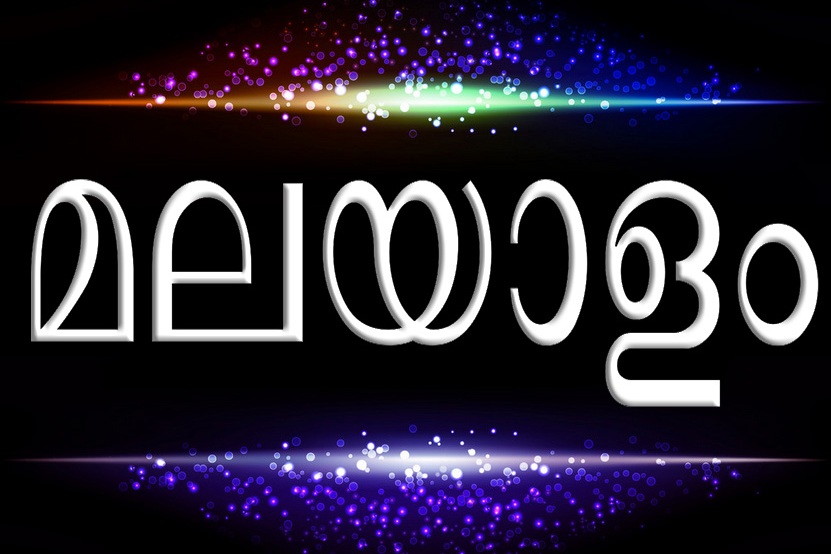
AuthorDivya NarayanaswamyUpdated on CategoriesLanguages12 Comments on ‘MALAYALAM’ (മലയാളം) – THE HISTORY :
‘MALAYALAM’ (മലയാളം) – THE HISTORY :
'MALAYALAM' (മലയാളം) - THE HISTORY:
Welcome to Protelo’s blog on Malayalam, one of South India’s most important languages. Please feel free to add your valuable comments, views or any other vital information about the Malayalam language at the end of this page in the comments section. Thanks in advance for reading through.

By Shan R
Malayalam (മലയാളം) is a Dravidian language spoken in the Indian state of Kerala and the union territories of Lakshadweep and Puducherry (Mahé) by the Malayali people, and it is one of 22 scheduled languages of India. Malayalam is spoken by 38 million people worldwide. Due to Malayali expatriates in the Persian Gulf, the language is also widely spoken in Gulf countries. Let’s now explore more about the Tamil language in detail.
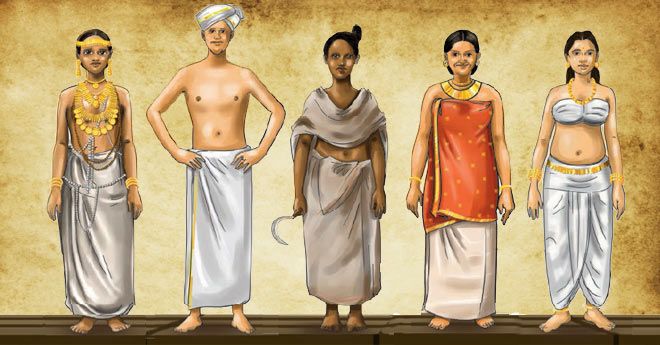
Origin :
The origin of Malayalam remains a matter of dispute among scholars. As Malai means mountain the word ‘M’ obviously refers to either people or the language of the mountainous region.
Although closely related to Tamil, Malayalam is more influenced by Sanskrit than Tamil. Scholars believe that the common ancestor of Tamil and Malayalam split in the 9th century AD, giving rise to Malayalam as a language distinct from Tamil. Tamil subsequently influenced the early development of Malayalam because it was the language of scholarship and administration. It developed into the current form mainly by the influence of the poet Thunchaththu Ezhuthachan in the 16th century. The oldest documents written purely in Malayalam and still surviving are the Vazhappalli Copper plates from 832 and Tharisapalli Copper plates from 849.
There are also a number of social varieties depending on caste and religion. There are differences in the speech of Christians, Hindus, and Muslims within a single geographic area. For instance, among the Hindus, the speech of Brahmins (the highest caste) differs from that of Nairs (a medium-high caste), and these, in turn, are distinct from the speech of Ezhava (low caste). The language of the high castes is more influenced by Sanskrit than the language of the lower castes; dialects spoken by Christians have more loan words from Portuguese, Latin, and English than other dialects. Dialects spoken by the Muslim population have many borrowings from Arabic and Urdu. At the same time, spoken Malayalam is rapidly becoming standardized due to the influence of mass education and the growing influence of mass media.
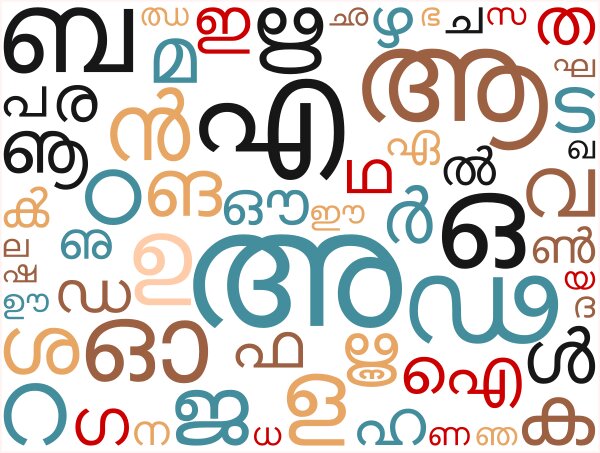
Script
The first inscription in Malayalam goes back to the 9th-10th centuries AD. Literature, consisting mostly of translated Hindu epics and lyric poetry, dates from the 13th century. Malayalam prose of different periods shows varying degrees of influence of other languages such as Tamil, Sanskrit, Hindi, Urdu, Arabic, Persian, Portuguese, Dutch, French, and English. Modern Malayalam literature is rich in poetry, fiction, drama, and biography. The state of Kerala boasts of a high literacy (up to 80%), the latter assuring the spread of literature. In Kerala alone, approximately 150 daily newspapers, over 200 weekly periodicals, and over 500 monthly journals are published in Malayalam.
The modern Malayalam alphabet was originally used to write Sanskrit only but is now used to write spoken Malayalam. The script was developed in the 13th century from a descendant of the Brahmi script and this is also known as Kairali script. The alphabet consists of 54 letters, 18 of which are vowels. It is a syllabic alphabet in which all consonants have an inherent vowel. Diacritics, which can appear above, below, before or after the consonant, indicate the change to another vowel or suppression of the inherent vowel. The shapes of Malayalam letters closely resemble those of Tamil, i.e., they have rounded shapes, so the script is sometimes referred to as the “round alphabet”. The roundedness has to do with the fact that in ancient times the writing was done by carving letters on palm leaves with a sharp point. Using this technique, it was apparently easier to produce curved lines rather than straight ones. A simplified version of the script was introduced in 1970-1980 to facilitate printing. The main change involved writing consonants and diacritics linearly rather than as complex characters. These changes are not applied consistently, so the modern script is often a mixture of traditional and simplified characters.
In Singapore and Malaysia, Malayalam is written with the Arabic script. The Arabic script is also used occasionally by Muslims in Kerala.
Modern Malayalam still preserves many words from the ancient Tamil vocabulary of Sangam literature.
Malayalam Alphabets:
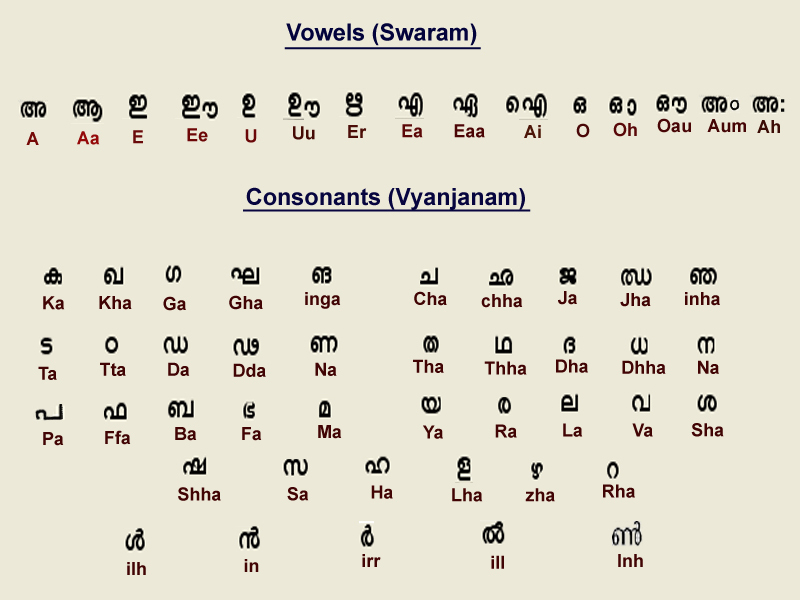
Malayalam Numbers:
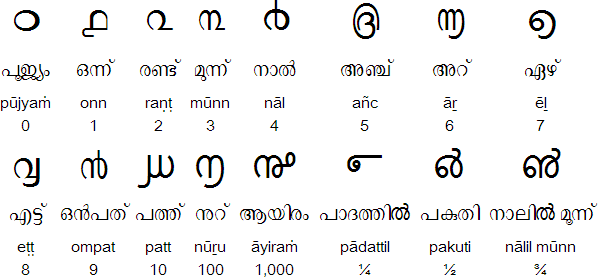
Vocabulary:
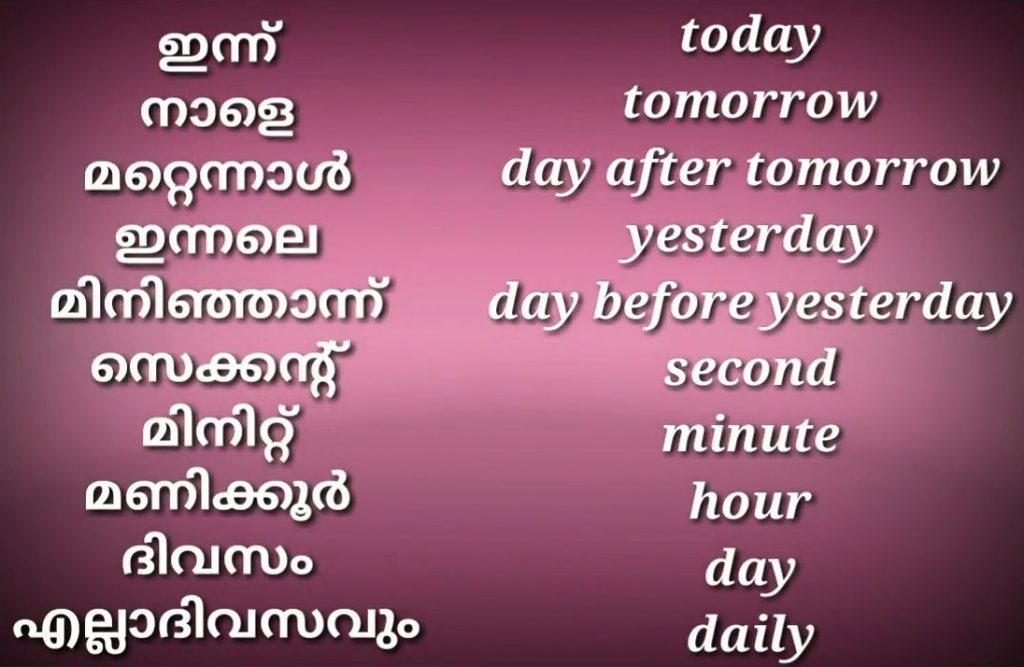
Malayalam language has a large vocabulary, with around 90,000 words listed in the dictionary. It consists of the number of words borrowed from Sanskrit and Proto-Dravidian language. The arrival of European further enriched the Malayalam vocabulary with large absorbing numerous words and idioms from English, Portuguese, and Dutch etc.
Nasalization:
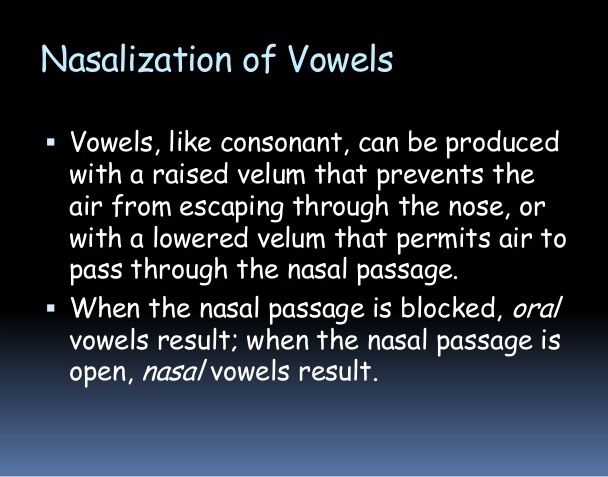
Most of the Malayalam words end with ‘am (ansvaram)’. Even vocabularies borrowed from Sanskrit are changed. For example, the Sanskrit root of Karma is actually Karman- is also changed to Karmam(കര്മ്മം,). Ramayana- Ramayanam (രാമായണം) Narasimha- Narasimham(നരസിംഹം) etc.

Age of Malayalam : The earliest known extent literacy work Ramacharitham(രാമചരിതം) was written in the late 13th century or early 13th century.
Dialects: There are 14 districts in Kerala, People of each districts speak different dialects.
Lakshadweep: Even though the language spoken in Lakshadweep is Malayalam, Keralites find it difficult to understand.
Classical status: Malayalam language got classical status recently.
Kendra Sahitya Academy Award: Malayalam literature got 57 Kendra sahitya academy awards.
Pronunciation: Nja(ഞ്ഞ),nga(ങ്ങ) , tt(റ്റ), nta(ന്റ) cannot be easily pronounced by non-malayalies.
Interesting Facts: The perfect alphabet and script. It has more letters than any other Indian script and the script is fully phonetic. Every other Indian language can be written in Malayalam but the reverse is not true.
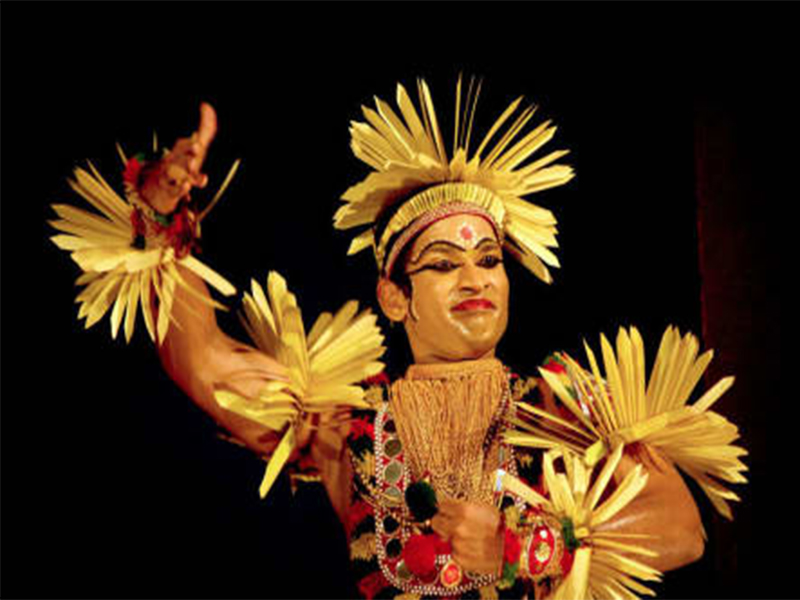
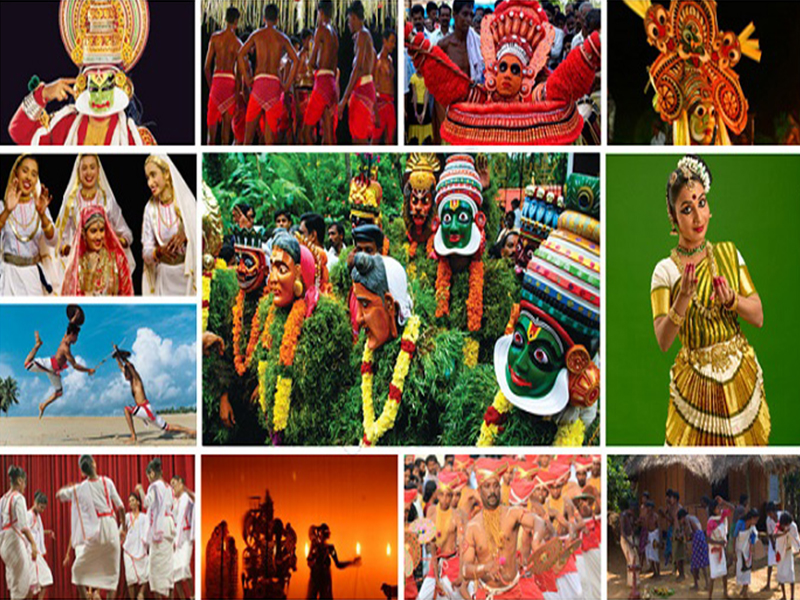
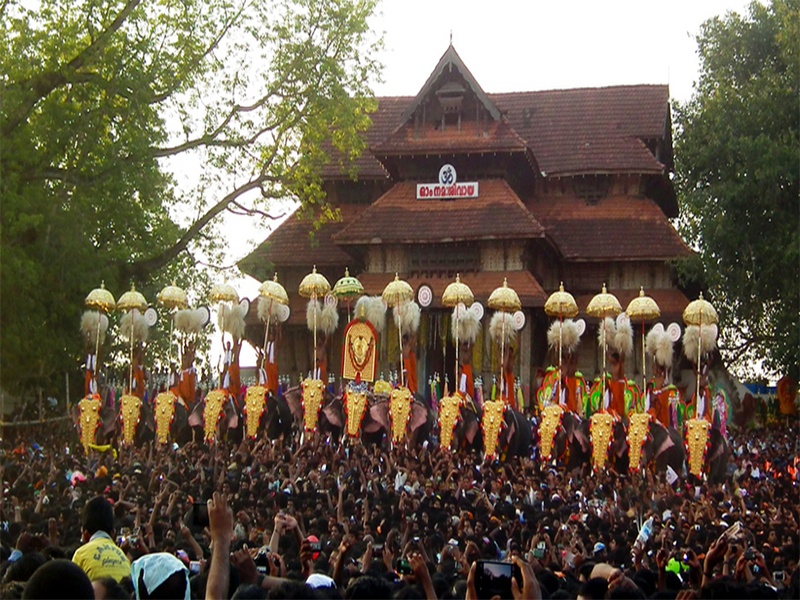
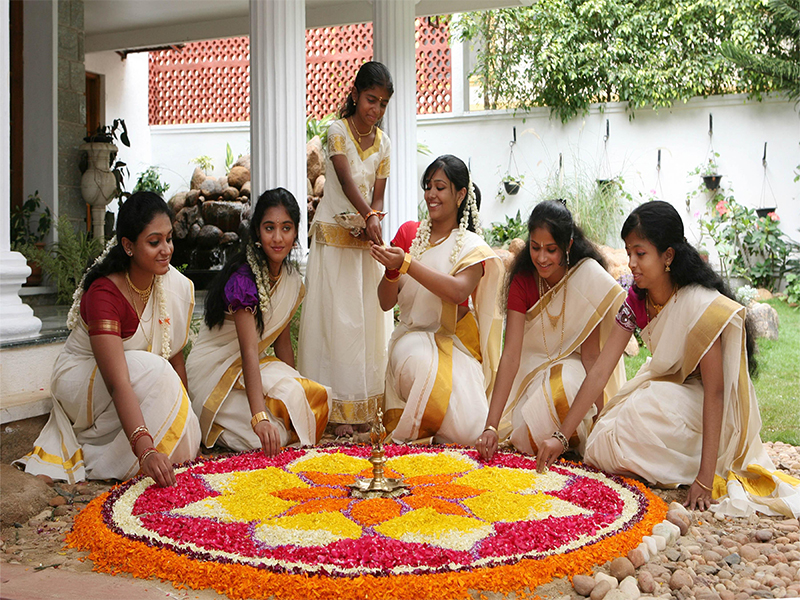
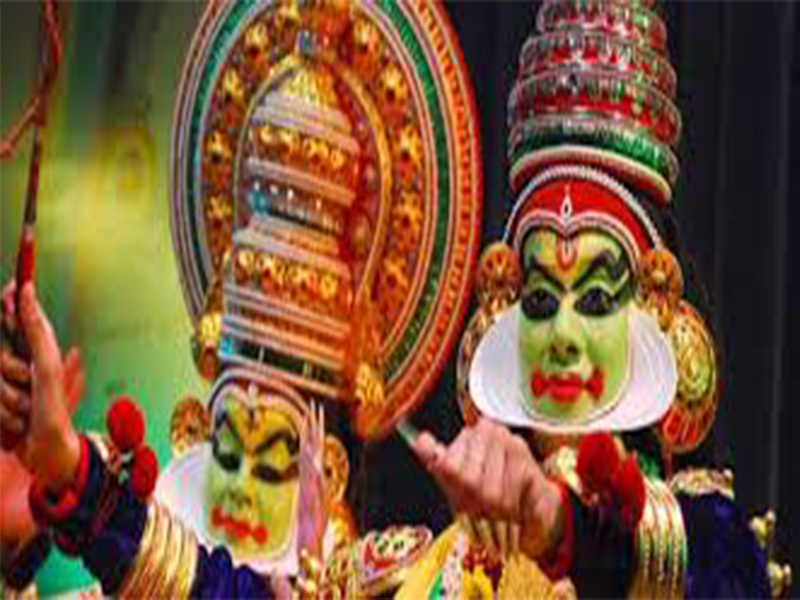
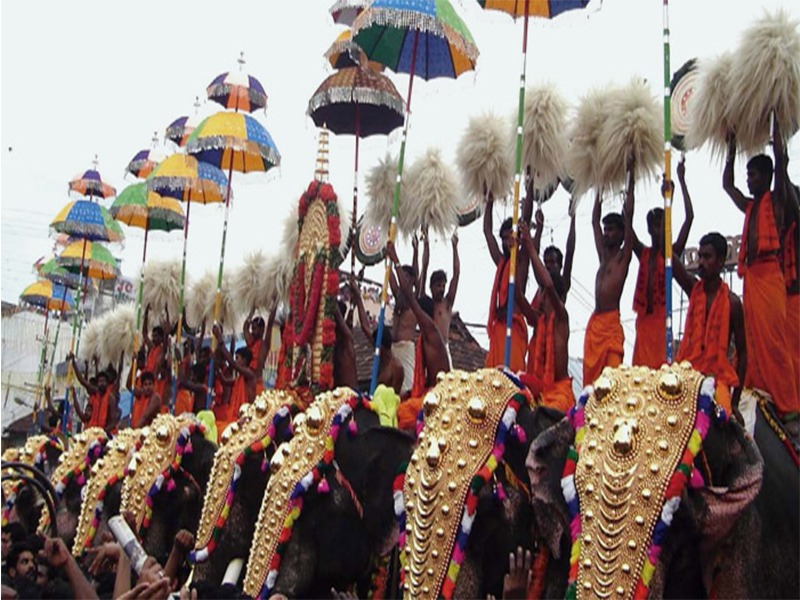
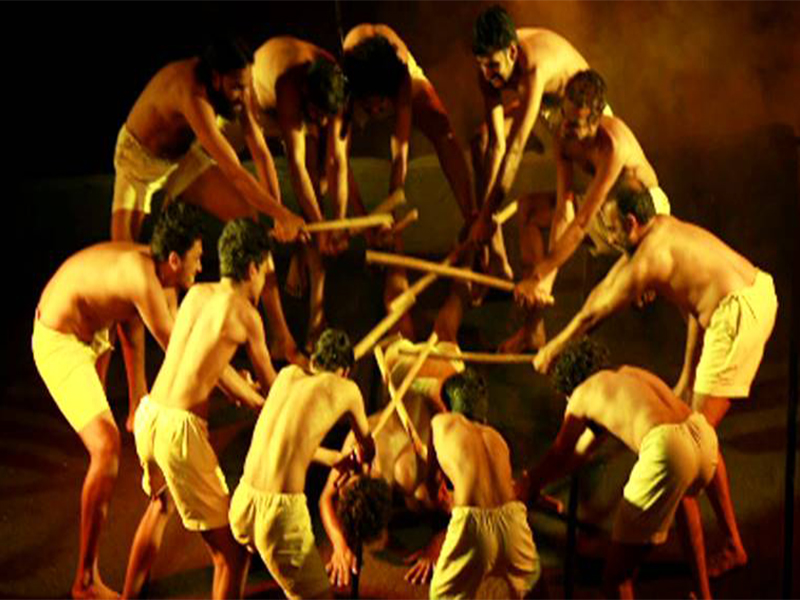


1.LOST LANGUAGE OF KERALA: MALAYALAM-TAMIL OR MALAYANMA
At present Malayalis are talking in a language which is mixture of Western Tamil and Nepali language. Few Sanskrit words also has been added to that “Nepali Malayalam” language. But the traditional language of Malayalis had been a pure Dravidian language called Malayalam-Tamil alias Malayanma language until 1830 AD.
From the Later Chera period Keralites were using Western Tamil or Malayalam-Tamil. Western Tamil known as “Old Malayalam” had been the state language of Kerala until 1830 AD.
Early Malayalam-Tamil was written with Tamil script or Vattezhuthu script.
LINGUA MALABAR TAMUL
Laterdays many variants of Malayalam-Tamil appeared. Portuguese had printed Christian books in Kerala in the native language of Keralalites, Malabar Tamil. Malayalam-Tamil was called by them “Lingua Malabar Tamul” or Malabar Tamul. Malabar Tamil was also called by Keralites as “Malabar Thamozhi”.
LINGUA MALABAR TAMUL BOOKS
1554 AD
Script: Portuguese
CARTILHA
(Catechisms)
1578 AD
Printed at: Kollam
Script: Tamil
THAMBIRAN VANAKKAM
1579 AD
Printed at: Kochi
Script: Tamil
KIRISTHIANI VANAKKAM
1680 AD
Script: Tamil
Printed at: Ambazhakkadu
FLOS SANCTORUM
(Flower of Saints)
Portuguese had used either Portuguese script or Tamil script to print Malabar Tamil books .
MALAYANMA
In Travancore Malayalam-Tamil language was also known as Malayanma. As the Malayanma writings always started after hailing Lord Shiva “Namashivaya” in the beginning, Malayanma was also known as “Naana Moona” or “Naanam Moonam”.
Southern Malayanma closely resembled Tamil. “Iravikuttipillapor” written in southern Malayanma survived destruction. Works in Northern Malayanma such as Vadakkan Pattukal written in the 17th century had vague resemblance to modern Malayalam but they were devoid of Nepali or Sanskrit words as in Modern Malayalam.
Malayanma language was written with Tamil script, Malayanma script, Vattezhuthu and Kolezhuthu scripts.
IRAVIKUTTY PILLA POR
Iravikuttipilla, commander of Venad’s army was in a dilemma whether to oppose the numerically superior army of Madurai Naickers sent by King Thirumalai Naicker. Iravikuttipilla resolved to fight Naickers but was defeated and martyred at Kaniyakulam war in 1634 AD. Southern Nairs called Pillais who had mixed with Vellalas, were using Malayanma language and they did not use the Nepali Malayalam used by other Nairs. “Iravikuttipillapor” written in Malayanma was a tribute to the bravery of Iravikuttipilla
Malayanma-Western Tamil
(transliteration)
Iravikuttipillapor (1634 AD)
இரவிக்குட்டிபிள்ள போர்
படைபோகாதிங்கிருந்தால் பாரிலுள்ளோர் நகையாரோ?
இந்தப்படை போகாதிருந்தால் இரவிக்குலத்துக்கிழுக்கல்லவோ?
ஏழுகடலப்புறத்திலிரும்பறைக்குள்ளிருந்தாலும்
எமராஜதூதர் வந்தாலில்லையென்றால் விடுவாரோ?
கல்லாலே கோட்டை கெட்டி கல்லறைக்குள்ளிருந்தாலும்
காலனுடயாளு வந்தால் கண்டில்லயென்றால் விடுவாரோ?
நமராஜதூதர் வந்தால் நாளையென்றால் விடுவாரோ?
விளைந்தவயலறுப்பதுக்கு விசனப்பெடவேண்டாம் கேள்.
__________________________________________
മലയാണ്മ-പടിഞ്ഞാറൻ തമിഴ്
(മലയാളം ലിപ്യന്തരണം)
ഇരവിക്കുട്ടിപ്പിള്ളപ്പോര് (എ.ഡി1634)
പടൈപോകാതിങ്കിരുന്താൽ പാരിലുള്ളോർ നകൈയാരോ?
ഇന്തപ്പടൈ പോകാതിങ്കിരുന്താൽ ഇരവിക്കുലത്തുക്കിഴുക്കല്ലവോ?
ഏഴുകടലപ്പുറത്തിരുമ്പറൈക്കുള്ളിരുന്താലും എമരാജദൂതർ വന്താലില്ലൈയെന്റാൽ വിടുവാരോ?
കല്ലാലേ കോട്ടൈ കെട്ടി കല്ലറൈക്കുള്ളിരുന്താലും
കാലനുടയാളു വന്താൽ കണ്ടില്ലെന്റാൽ വിടുവാരോ?
നമരാജദൂതർ വന്താൽ നാളൈയെന്റാൽ വിടുവാരോ?
വിളൈന്തവയലറുപ്പതുക്കു വിചനപ്പെടവേണ്ടാം കേൾ
2.LOST LANGUAGE OF KERALA: MALAYALAM-TAMIL OR MALAYANMA
NORTHERN MALAYANMA
The Malayanma used in Malabar especially Kadathanad was also a purely Dravidian language. Vadakkan Pattukal in Malayanma were a compilation of songs of Malabar.
வடக்கன் பாட்டுகள் (ஒலிப்பெயர்ப்பு)
பாறக்கூட்டங்ஙளில் தடம் தல்லி, முத்துமணிகள் விதறி ஒழுகுன்ன காட்டருவிகள்… பகல்போலும் சூர்யன் ஒளிஞ்ஞுநோக்கான்மாத்ரம் கழியுன்ன இருள் சேர்ன்ன காடுகள், பச்சக்கம்பிளி மூடி குன்னுகள், இடயில் நெல்க்கதிருகள் நிருத்தமாடுன்ன வயலுகள். வயல்நாடாணு வயநாடு”.
(பய்யம்பள்ளி சந்து)
__________________________________________
വടക്കൻ പാട്ടുകൾ(മലയാളം ലിപ്യന്തരണം)
“പാറക്കൂട്ടങ്ങളിൽ തടംതല്ലി, മുത്തുമണികൾ വിതറി ഒഴുകുന്ന കാട്ടരുവികൾ… പകൽപോലും സൂര്യന് ഒളിഞ്ഞുനോക്കാൻമാത്രം കഴിയുന്ന ഇരുൾ ചേർന്ന കാടുകൾ, പച്ചക്കമ്പിളി മൂടി കുന്നുകൾ. ഇടയിൽ നെൽക്കതിരുകൾ നൃത്തമാടുന്ന വയലുകൾ. വയൽനാടാണ് വയനാട്.
പയ്യമ്പള്ളി ചന്തു(വടക്കൻ പാട്ടുകൾ)
VARIANTS OF MALAYANMA
KARSHONI MALAYALAM
Karshoni Malayalam of Syrian Christians was Western Tamil written with Garshuni Syriac script. Karshoni was not a literary language but a language which had been used by foreign Syrian traders to write business details in medieval Tamil.
ARABI MALAYALAM
“Mappilla Malayalam” or Arabi Malayalam was used by Mapilla Muslims which was a form of Malayanma which had some Arab words but was devoid of Nepali or Sanskrit words. Mapilla Malayali was written using Arabic script. Mapilla Malayalam was a Dravidian language used by Maraikkayars who had descended from Ship keepers of Chera Navy. “Marakkayam” meant ship in medieval Tamil. Mapilla Malayalam might have evolved at Ponnani which was known as Tondi in ancient times.
EZHAVA MALAYANMA
Ezhavas who excelled in medicine and Botany used a form of Malayanma which was written using Kolezhuthu Script. Ezhava scholar Itty Achuthan in 1675 AD, wrote the description of plants in Malayanma language using Kolezhuthu, in the Botany-Medicine work “Hortus Malabaricus”.
NADAR MALAYANMA
Nadars used a southern version of Malayanma but it had many Sanskrit technical words. Malayanma script was used to write these books. Thousands of palmleaf manuscripts written in Malayanma language, in varied subjects such as Ayurvedha, Martial Arts, Varmam, Siddhu, Uru, Witchcraft etc were possesed by Malayali Nadars.
TAMIL ROOTS OF MALAYALIS
Most of the Malayalis had origins from medieval Tamils hence they had used Malayalam-Tamil. Even after their intermixture with Srilankans, Arabs and Portuguesemen, the vernacular language of Keralites continued to be Malayalam-Tamil or Malayanma until 1830 AD.
TULU-NEPALI INVASION
Nairs, Nambuthiris and Samantha Kshatriya who ruled Kerala between 1333 AD to 1947 AD were not Tamils but Tulu-Nepali invaders who invaded Kerala in 1120 AD. A Tulu prince called Banapperumal had invaded Kerala with Arab support in 1120 AD and captured Malabar. Banapperumal had attacked Kerala with a Nepali Nair mercenary army. Tuluva Brahmins called Nambuthiris were the leaders of the Nair army, which invaded Kerala in 1120 AD.
After establishing Kolathiri Kingdom and other Tulu matrilineal kingdoms in Malabar Banapperumal embraced Islam religeon and went to Arabia for pilgrimage in 1156 AD.
3.LOST LANGUAGE OF KERALA: MALAYALAM-TAMIL OR MALAYANMA
AHICHATRAM IN NEPAL
Nairs and Nambuthiries had been brought from Ahichatra, capital of ancient Nepal to Karnataka in 345 AD by Kadamba king Mayura Varma. Nairs and Nambuthiries conversed with each other in an ancient Nepali tongue. After coming to Kerala in 1120 AD, a Nepali mixed Malayalam was used by Nairs and Nambuthiris.
DOMINANCE OF NEPALIS OVER TULU SAMANTHA DYNASTIES
As both the Nairs and Nambuthiris originated from Ahichatram in Nepal, Nair armies had obeyed only Nambuthiris. The weak Tulu dynasties of Malabar were converted to matrilineal dynasties and Nambuthiris forced the Tulu kings’ sisters to have courtship with them.
TULU-NEPALI DYNASTIES
The sisters of reigning king from the Tulu dynasty established by Banapperumal had courtship (Sambandham) with Tuluva Brahmin Nambuthiris and the sons thus born became the next king with the title Thirumulpad or Nambiadri.
ESTABLISHMENT OF TULU-NEPALI RULE
After the invasion of Turkish sulthanate in 1311 AD all the Tamil Villavar Kingdoms came to an end. In the second attack of Delhi Sulthanate in 1323 AD led by Ulugh khan, Kerala was also occupied. The Tulu-Nepali kingdoms of Malabar had been the allies of Arabs and Turks. The Villavar dynasty which ruled Villarvettom kingdom with capital at Chendamangalam, and Cherai dynasty which ruled Venad with capital at Kollam were weakened by this attack.
After this period matrilineal Tulu-Nepali dynasties which had ruled Malabar between 1156 AD to 1323 AD, migrated to south and occupied the Tamil Villavar kingdoms. At Venad, a Tulu-Nepali princess called Attingal Rani who had bee sent from Kolathiri kingdom established a matrilineal dynasty at Attingal in 1333 AD. The Perumbadappu dynasty which had capital at Vanneri near Ponnani lake moved south and established the Kochi kingdom at 1335 AD. The Tharoor Swaroopam which hitherto had ruled from Athavanad migrated to south and established the Palakkad kingdom. At 1335 AD, all Kerala came under alien matrilineal Tulu-Nepali rulers.
TWO MALAYALAMS
There were two Malayalam dialects in Kerala after the Tulu-Nepali overlordship in 1333 AD.
1. MALAYALAM-TAMIL OR MALAYANMA LANGUAGE
Malayalam-Tamil was used by indigenous Dravidians of Kerala, Christians and Muslims who also had Dravidian roots. Malayalam-Tamil was derived from Western Tamil of Chera dynasty. Malayalam-Tamil was the majority language of Kerala when Portuguese arrived.
2. NEPALI MALAYALAM
Nepali Malayalam had been used by matrilineal Tulu-Nepali clans such as Nairs, Nambuthiries and Tulu Samantha Kshatriyar. Nepali Malayalam was the Malayalam intermixed with the ancient Nepali tongue of Nairs and Nambuthiris. Nepali Malayalam was written with Tulu(Tigalari) Script.
MANIPRAVALAM
The Tuluva Brahmin Nambuthiries mixed western Tamil with Sanskrit and created Manipravalam language, which was used by them between 1200 AD to 1400 AD. Manipravalam was written with Tulu(Tigalari) Script.
LILATILAKAM
Lilatilakam written in the 14th century was book on grammar and poetry of Manipravalam language.
UNNUNEELI SANDESAM
Unnuneeli Sandesam, was a sandesa kavyam written around 1380 AD in Manipravalam language during the reign of Venad king Adityavarma Sarvanganathan. Adityavarma Sarvanganathan was the hero of the Unnuneeli Sandesam.
Adityavarma Sarvanganathan was from the matrilineal Tulu-Nepali dynasty of Venad established in 1333 AD by Tulu princess Attingal Rani. Adityavarma Sarvanganathan who ascended throne in 1376 AD tried to evict Turkish armies by aligning with a Thirunelveli Pandya called Vikrama Pandiyan. But in 1377 AD, Vijayanagara Naickers occupied Tamilnadu.
Unnuneeli, the heroine who was romantically involved with Adityavarma Sarvanganathan was residing at Kaduthuruthi.
Manipravalam was purely an early literary language of Tulu-Nepali Brahmins which was not understood by Dravidian Malayalis. Tulu-Nepali Brahmins of Kottayam in Thekkumkur kingdom tried to replace western Tamil by Sanskrit based Manipravalam in the 14th century.
4. LOST LANGUAGE OF KERALA: MALAYALAM-TAMIL OR MALAYANMA
GRANTHA MALAYALAM
In the 16th century Thunchathu Ramanujan Ezhuthachan wrote “Adhyathmaramayanam” in a Sanskritised Malayalam, called “Grantha Malayalam”. Adhyathmaramayanam was written with Tulu script.
As Grantha Bhasha was purely a literary language it was understood only by Nambuthiris and few Nairs with Sanskrit literacy .Tulu-Tigalari script was not known to ninety percent Malayalis especially Dravidian Malayalis then and they did not know Sanskrit also then.
“NEPALI MALAYALAM” BOOKS
Nairs and Nambuthiris had been talking with each other in their ancient Nepali tongue which in the 17th century they mixed it with the local Dravidian tongue, Malayalam-Tamil and they started writing books in this language using Tulu script.
The Kerala history books such as Keralolpathi written in Nepali Malayalam, and Kerala mahatmyam written in Sanskrit, by Nambuthiris and Nairs using Tulu script, in the seventeenth century, did not mention any Tamil Chera Villavar dynasty kings and their many thousand year old history. The Tamil Sangham era was not mentioned. Neither the Dravidian Tamil Villavar clans such as Villavar, Malayar and Vanavar clans who supported the Chera dynasty was mentioned.
Instead in Keralolpathi, the Tulu invader Banapperumal was mentioned as Cheraman Perumal and his son Udayavarman Kolathiri who founded the matrilineal Kolathiri dynasty, had been called as “Cheraman Vadakkan Perumal”. According to “Keralolpathi” the Tulu-Nepali people from Ahichatram in Nepal were the founders of the civilization in Kerala. The book Keralolpathi mentioned that Lord Parasurama reclaimed Kerala from sea and gave it to Nambuthiris in the ancient times. In fact Arabs had brought Tulu invader Banapperumal, Nambuthiris and Nairs to Kerala in 1120 AD from Tulunadu.
The Sanskrit work Kerala Mahatmiyam mentioned that the Tulu invader Banu Vikrama Kulasekharapperumal alias Banapperum was crowned as king of Kerala by Lord Parasurama. In reality Banapperumal was a Buddhist Tulu prince who allied with Arabs, who invaded Kerala in 1120 A.D with a Nair army. Banapperumal was crowned as king of northern Kerala ie Malabar by Arabs. Banapperumal eventually embraced Islam and sailed to Arabia for pilgrimage in 1156 AD. His son Udayavarman Kolathiri who founded Kolathiri dynasty was also a Buddhist.
TULU-NEPALIS AT SANGAM ERA
The claims made by Tulu -Nepali invaders such as Nambuthiris, Nairs and Samantha Kshatriyas as the original inhabitants of Kerala was supported by European Christian missionaries. The reason behind that was because the European missionaries had fabricated a fable that St.Thomas had converted Nambuthiris to Christianity in A.D 52 .
Thus Sangam age Tamils of ancient Kerala were replaced by Tulu-Nepali clans such as Nambuthiris, Nairs and Samantha Kshatriyas who were presented as the inhabitants of ancient Kerala in Kerala history books.
SANSKRITIZATION OF MALAYANMA BY CHRISTIAN MISSIONARIES
In the 18th century European Christian missionaries dreamed of making Sanskrit as the Liturgical language of Indian Christians.
Nairs and Nambuthiris had been conversing with each others in a Nepali mixed Malayalam because of their origin from Nepal. But European missionaries mistook that Nairs and Nambuthiris were talking with each others in a Sanskritized Malayalam. The Sanskrit mixed Malayalam-Tamil, known as “Grantha Bhasha” or “Grantha Malayalam” language had been used by Ezhuthachan to write Adhyatma Ramayanam, in the 16th century. Grantha Bhasha was purely a literary language and not a spoken language. But European missionaries started studying Grantha Malayalam and Sanskrit in the 18th century though no Christians of Kerala knew Sanskrit or Grantha Malayalam or the Tulu(Tigalari Script) with which these languages were written.
5. LOST LANGUAGE OF KERALA: MALAYALAM-TAMIL OR MALAYANMA
ARNOS PATHIRI
In 1700 AD a Dutch German missionary called Arnos Pathiri wrote a grammar book called “Granthabhashayude Vyaharanam” for Grantha Bhasha.
FOUR LANGUAGES
The Syrian Christian priests who had been under the influence of European missionaries were forced to study four languages ie Malayanma, Syriac, Portuguese and Sanskrit in the 18th century.
ADDING SANSKRIT WORDS
European Christian missionaries started adding Sanskrit words to Malayanma and printed christian worship books in this hybrid language.
SYMBOLUM APOSTOLORUM
In 1711 AD a book called “Symbolum Apostolorum” ie History of Apostles, which was written in a Sanskrit mixed Malayanma, was printed with Malayanma script. By 1750s two Sanskrit colleges were established in Rome and Geneva to train Christian priests in Sanskrit.
SAMKSHEPA VEDARTHAM
In 1772 AD, “Samkshepa Vedartham” a Christian prayer book with heavy mixture of Sanskrit was printed at Rome. But these Sanskritised Malayanma books were not accepted by Keralas Christians who had no knowledge of Sanskrit.
RAMBAN BIBLE
Last book to be printed with Sanskrit enriched Malayanma was “Ramban Bible” written in 1811 AD by Rev. Philipose Ramban. That also was rejected by Keralas Christians as they did not know Sanskrit.
After this European missionaries abandoned Malayanma and started studying the Nepali Malayalam used by Northern Kerala Nairs and Nambuthiris as spoken language.
ESTABLISHMENT OF CHURCH MISSION SOCIETY
Church Mission Society established in 1815 at Kottayam, started promoting the “Nepali Malayalam” the spoken language of Nairs and Nambuthiris. At Church mission society the Syrian Christian priests were taught the Nepali Malayalam written with Tulu script. But it produced no scholars in Nepali Malayalam among Syrian Christians.
NEPALI MALYALAM PRINTING TYPES
In 1821 British Missionary Benjamin Bailey went to Mangalore to study Tulu script. At Basil mission in Mangalore, Benjamin Bailey made printing types with a modified Tulu script in 1821 AD, for printing Nepali Malayalam books.
HINDU BIBLE
It is interesting to note the first Nepali Malayalam Bible published by British missionary Benjamin Bailey in 1829 AD was written by two Hindus called Chathu Menon and Vaidhyanatha Aiyar.
It was because in the 1829 A.D Dravidian Malayanma language had been the language of Kerala Christians. Syrian Christians did not know the Nepali Malayalam which had been exclusively used by Nairs and Nambuthiries then. So British had to recruit a Nair called Chathu Menon from Ottapalam to write the Bible in Nepali Malayalam and a Tamil Brahmin called Vaidhyanatha Aiyar to add Sanskrit words to it.
ATTEMPT TO CONVERT NAIRS TO CHRISTIANITY
The Malayanma language of Kerala was destroyed by British missionaries who wanted to convert Nairs to Christianity. British and German missionaries started promoting the Nepali Malayalam excusively spoken by Nairs and Nambuthiris in 1830 AD.
The British and German missionaries wanted to convert Nairs to Christianity but the Nairs had been talking Nepali Malayalam which was unknown to Syrian Christians. Syrian Christians were talking Dravidian Malayanma language then. British missionaries conspired to make the Nepali Malayalam as the language of Bible though no Christian was talking Nepali Malayalam in 1815 AD.
So in 1815 AD the British missionaries started teaching Nepali Malayalam to Syrian Christian priests at the seminary at Kottayam. They converted a Tulu -Nepali prince from Vellarappalli Kovilakam of Kochi, to Christianity and he was the renamed as Yakoob Ramavarman. Yakoob Ramavarman was ordained as a priest but he preferred to give his sermons in Tamil and not in Nepali Malayalam.
Then European missionaries then employed Chathu menon and his sons Govindan Kutty menon and Padmanabha menon, who were instrumental in writing the first Nepali Malayalam bible, written by Hindus.
6. LOST LANGUAGE OF KERALA: MALAYALAM-TAMIL OR MALAYANMA
PROMOTION OF NEPALI MALAYALAM BY EUROPEANS
The Nepali Malayalam talked by Nairs and Nambuthiris exclusively was made official Malayalam, under the influence of Christian missionaries such as Benjamin Bailey and Herman Gundert in the ninenteeth century. Malayanma, the traditional Dravidian tongue of Malayalis was replaced by Nepali Malayalam after 1830 AD.
DECLINE OF MALAYANMA
After 1830 AD, only a handful of books written in Nepali Malayalam by Nairs and Nambuthiris after the sixteenth century were accepted as Malayalam. Malayalam-Tamil and Malayanma books written by Dravidian Malayalis over a thousand years were not accepted as Malayalam. No attempt to preserve thousands of Malayanma books written in Palmleaf manuscripts, was made by neither British or the matrilineal Tulu-Nepali rulers of Kerala. Thus British missionaries helped the alien Tulu-Nepali people to establish Nepali Malayalam as the official Malayalam.
This is as if a Malayali goes to Nepal and force Nepalis to speak malayalam and make Malayalam official language of Nepal.
BANNING OF MALAYANMA
In a conspiracy hatched by the British Christian missionaries the Nepali Malayalam spoken by Nairs and Nambuthiris was made the official Malayalam and the Dravidan Malayanma was banned. Thousands of books written in Malayanma (Malayalam-Tamil) disappeared.
COLLUSION OF SYRIAN CHRISTIAN’S WITH EUROPEANS
The Syrian Christians had colluded with the European missionaries and they were the first to learn Nepali Malayalam. British missionaries Benjamin Bailey and German missionary Herman Gundert were instrumental in the destruction of Dravidian Malayanma language and promotion of Nepali Malayalam. But the European missionaries were not able to convert any Nairs to Christianity.
But the Dravidian Malayalis who lost their ancestral language Malayanma were easily suppressed by British.
CHANGED SCRIPT OF THE LANGUAGES
The British changed the writing system of Kerala from Malayanma, Tamil, Vattezuthu and Kolezhuthu writing systems to Tulu-Tigalari writing system. But at Tulunadu British banned the usage of Tulu script and encouraged the usage of Kannada script. By this British were able to suppress Tulunadu also.
SCHOOLS TEACHING NEPALI MALAYALAM
When schools were established at Trivandrum in 1836 AD only Nepali Malayalam was taught there not the traditional Malayanma language.
British missionary John Roberts, who was the headmaster of the LMS seminary at Nagercoil started the first Government school of Kerala at present “University college” premises at Trivandrum in 1836 AD. Nepali Malayalam which had been the private language of Nairs and Nambuthiris till then was taught as official Malayalam there.
MODERN NEPALI MALAYALAM
Modern Malayalam is nothing but the Nepali Malayalam written with Tulu Script first taught by British missionaries. The Tulu writing system of Modern Malayalam was also introduced by British missionaries such as Benjamin Bailey.
MALAYALAM AS A NEPALI DIALECT
European missionaries played an important role in converting Malayalam into a Nepali dialect.
Since then Nairs have been adding further Nepali words to Malayalam.
Now any Nair can say a Nepali word and claim that it is only a Malayalam word.
7. LOST LANGUAGE OF KERALA: MALAYALAM-TAMIL OR MALAYANMA
PALAYUR COPPER PLATE
Kollam 781
1606 AD
Script: VATTEZHUTHU
Language : MALAYALAM-TAMIL
Plate belonging to Syro-Roman Church of Palaiyur.
Deed written in 1606 AD.A certain Iravi Narayanan resident of Kuttancherry had received a loan of 1055 Panam from the Vicar of Palayur Church and the functionaries of the Church.
The document recordes the transfer of a landed property situated in Ilangulum in Irinnappuram desam called Vadakemuri land and the adjoining land with forty Nazhi seed sowing capacity owned by Ravi Narayanan, to Palur Church Vicar Paru Kulankara Itty Achanar as parallel to 1055 Panam and interest.
In this way Palur Church Vikari Paru Kulankara Itty Achanar and Functionaries made this land deed written.
Nambuthiri of Kothanallur was a witness. Document was written by Madakkavu Sattappa Menon.
This copper plate does not have any Nepali words.
பாலையூர் தாமிர தகடு.
கொல்லம் 781
கிபி 1606
எழுத்து முறை : வட்டெழுத்து
First Side.
1. கொல்லம் ௭௱௮௰௧(781) -மத கும்ப ஞாயற்றில் எழுதிய வெம்
2. பாட்டம் நெற் பலிச ஓலகரணமாவத பாலூற்பள்ளிலெ விகாரியும்புரொ
3. த்திக்காரரும் கூட கைய்யால் ஆயிரத்த அன்ம் பத்த அஞ்
4. சு புது பணம் கொண்டான் கூத்தம்செரி இரெவிநாராணென்
5. கொண்டான் கொண்டன பரிசாவத இக்கொண்ட புது௧(1) பணம் ௲௫௰
6. ௫ (1055) னும் காரியம் தன்ற்றெ இரிங்ஙப்புரம் தெசத்த இளங்
7. குளத்த வடிக்கெமுறி பறம்பும் அதின அடுத்த கண்டங் ங
8. ள் நால்ப்பதினாழி வித்தினு கண்டவும் கூட நில பா
9. ட்டமுள்ப்பட ஆயிரத்த அன்ம்பத்த அஞ்சு பணத்தின
Second Side.
10. நெற்பலிச கிழிடுமாற எழுதிக் கொடுத்தான் இரெவி நாராணென்.
11. இம்மார்க்கமெ இச்சொன்ன இளங்குளத்தெ வடக்கெமுறிப் பறம்
12. பும் அதிடுத்த கண்டம் நானாழி வித்தின்னு கண்டவும் கூடி ஆ
13. யரத்த ௲௫௰௫(1055) த்தின்ன நெற்பலிச கிழியுமாற எழு
14. திச்சு கொண்டாற் பாலூற் பள்ளியில் விகாரி பரூக்குளங்ஙரெ
15. இட்டி அச்செனாரும் புரொத்திக்காரரும் கூடி இப்படிக்க
16. இதட்டுயும்(இத அறியும்) தாழ்க்கி கொதநல்லூர் நம்புதிரி மா
17. டக்காவில் சாத்தப்பமெனோன் கையழுத்த
__________________________________________
പാലയൂർ ചെമ്പ് തകിട്
കൊല്ലം 781
1606 എഡി
ലിപി: വട്ടെഴുത്ത്
ഭാഷ: മലയാളം-തമിഴ്
മലയാളം (ലിപ്യന്തരണം)
1. കൊല്ലം 781 – മത കുമ്പ ഞായറ്റിൽ എഴുതിയ വെം
2. പാട്ടം നെറ് പലിശ ഓലകരണമാവത പാലൂറ്പള്ളിലെ വികാരിയും പുരൊ
3. ത്തിക്കാരരും കൂട കൈയ്യാൽ ആയിരത്ത അൻമ്പത്ത അഞ്ച്
4. പുതു പണം കൊണ്ടാൻ കൂത്തംചെരിഇരവിനാരാണെൻ
5. കൊണ്ടാൻ കൊണ്ടന പരിശാവത ഇക്കൊണ്ട പുതു(1) പണം 105
6. 5 നും കാരിയം തന്റ്റെ ഇരിങ്ങപ്പുരംദെശത്ത ഇളങ്
7. കുളത്ത വടിക്കെമുറി പറമ്പും അതിന അടുത്തകണ്ടങ്ങ
8. ൾ നാല്പ്പതിനാഴി വിത്തിനു കണ്ടവും കൂട നില പാ
9. ട്ടമുൾപ്പട ആയിരത്ത അന്മ്പത്ത അഞ്ച്പണത്തിന
Second Side.
10. നെറ്പലിശ കിഴിടുമാറ എഴുതിക്കൊടുത്താൻഇരവി നാരാണെൻ
11. ഇമ്മാർക്കമെ ഇച്ചൊന്ന ഇളങ്കുളത്തെ വടക്കെമുറിപ്പറമ്പും
12. അതിടുത്ത കണ്ടം നാനാഴി വിത്തിന്നു കണ്ടവുംകൂടി ആ
13. യരത്ത 1055 ത്തിന്ന നെറ്പലിശകിഴിയുമാറ എഴു
14. തിച്ചു കൊണ്ടാറ് പാലൂറ് പള്ളിയിൽ വികാരി പരൂക്കുളങ്ങരെ
15. ഇട്ടി അച്ചെനാരൂം പുരൊത്തിക്കാരരും കൂടിഇപ്പടിക്ക
16. ഇതട്ടുയും (ഇത അറിയും) താഴ്ക്കി കൊതനല്ലൂർ നമ്പുതിരി മാ
17. ടക്കാവിൽ ചാത്തപ്പമെനോൻകൈയഴുത്ത.
__________________________________________
The Palayur plate of 1606 AD written by a Nair called Chathappa menon and in which a Nambuthiri had been a witness, had been written in Malayalam-Tamil language with Vattezhuthu script which were used in official documents then.
The Nepali Malayalam written in Tulu script remained the private spoken language of Tulu-Nepali clans such as Nairs, Nambuthiris and Samantha Kshatriyas but unknown to rest of the Keralites.
8. LOST LANGUAGE OF KERALA: MALAYALAM-TAMIL OR MALAYANMA
PALAIYUR PLATE OF KOLLAM ERA 918.
1743 AD
Language: MALAYALAM-TAMIL
Script: VATTEZHUTHU
1. கொல்லம் ௯௱௰அ(918)-மத மீனஞாயற்றில் எழுதிய அட்டிப்பெற்றொலக் கருணமவது பாலயூர் தெசத்த அச்சழித்த
2. கும்மனிய்ப்பறம்பின்ன தெக்கெப்புறம் இம்பொணன் கல்லட்ட அதிற்க்கதெக்கொட்டும் பள்ளிபறம்பின்ன வடக்
3. கெ அதிற்க்க வடக்கொட்டும் படிஞ்ஞாற எடவழிக்க கிழக்கொ ட்டும் கிழக்கெ அற்க்க படிஞ்ஞாட்டும்
4. இ நாலதிற்க்க அகத்தகப்பெட்டத எப்பியெற்பெட்டதும் அந்நு நால றகண்டு யெடம் அற்த்தவும்
5. வாங்ஙி அட்டிப்பெற பிறமுதெலொதகமயி எழுதி கொடுத்தான் அச்சழி த்த ராமன் பங்ஙனும்
6. தம்பிமரும் அம்மாற்க்க இச்சொன்ன பலையூற் தெசத்த அச்சா ழியத்த கும்மனிப்ப
7. ன்ன தெக்கெப்புறம் கல்லிட்ட திற்க்க தெக்கொட்டும் பள்ளிபறம்பி ன்ன வடக்கே அதிற்க்க
8. வடக்கொட்டும் படிஞ்ஞாற எடவழிக்க கிழக்கொட்டும் கிழ க்கெ அற்க்க படிஞ்ஞாட்டும் இந்
9. நாலதிற்க்ககத்தகப்பெட்டத எப்பிற்பெட்டதும் அந்நு நாலறகண்டு யெ டம் அற்த்தவும் கொடுத்த
10. அட்டிப்பெற பிறமுதலொதகமாயி எழுதிச்சு கொண்டன் பலையூர் ப ள்ளி வெகரியும் பொறத்திக்காரும் இம்மாற்க்கமெ
11. இச்சொன்ன பறம்ப அந்நு நாலறகண்ட யெடம் அற்த்தவும் வாங்ஙி பிற முதெலொதகமாயி எழுதி கொடுத்தான் ராமன் பங்ஙனும்
12. தம்பிமரும் அம்மற்க்கமெ இச்சொன்ன பறம்ப அந்நு யெடம் அற்த்தவும் கொடுத்த பிறமுதெலொதகமாயி எழுதிச்சு
13 கொண்டன் பாலயூர் பள்ளி வெகாரியும் பொறவற்த்திக்காரும் இம்ம ற்க்கமெ அறியும் பலதக்கி தலப்பெள்ளி
14. யரு வெற்காவெக்கரூ கூடவ்வும் சவுலக்கட்டில் நட்டரு மம்மம்பில் முத்தவ்வெரும் கூத்தாம்பெ
15. ள்ளி கம்மளும் அறிகெ கொங்ஙாட்டில் கேரளன் கண்டர் கய்யெழுத்த
__________________________________________
പാലയൂർ ചെപ്പേട്,
കൊല്ലം 918.
1743 AD
ഭാഷ: മലയാളം-തമിഴ്
ലിപി: വട്ടെഴുത്ത്
മലയാളം ലിപ്യന്തരണം
1. കൊല്ലം ௯௱௰அ(918)-മത മീനഞായറ്റിൽ എഴുതിയ അട്ടിപ്പെറ്റൊലക് കരുണമവതു പാലയൂർ തെചത്ത അച്ചഴിത്ത
2. കുമ്മനിയ്പ്പറമ്പിന്ന തെക്കെപ്പുറം ഇമ്പൊണൻ കല്ലട്ട അതിറ്ക്കതെക്കൊട്ടും പള്ളിപറമ്പിന്ന വടക്
3. കെ അതിറ്ക്ക വടക്കൊട്ടും പടിഞ്ഞാറ എടവഴിക്ക കിഴക്കൊട്ടും കിഴക്കെ അറ്ക്ക പടിഞ്ഞാട്ടും
4. ഇ നാലതിറ്ക്ക അകത്തകപ്പെട്ടത എപ്പിയെറ്പെട്ടതും അന്നു നാല റകണ്ടു യെടം അറ്ത്തവും
5. വാങ്ങി അട്ടിപ്പെറ പിറമുതെലൊതകമയി എഴുതി കൊടുത്താൻ അച്ചഴിത്ത രാമൻ പങ്ങനും
6. തമ്പിമരും അമ്മാറ്ക്ക ഇച്ചൊന്ന പലൈയൂറ് തെചത്ത അച്ചാഴിയത്ത കുമ്മനിപ്പ
7. ന്ന തെക്കെപ്പുറം കല്ലിട്ട തിറ്ക്ക തെക്കൊട്ടും പള്ളിപറമ്പിന്ന വടക്കേ അതിറ്ക്ക
8. വടക്കൊട്ടും പടിഞ്ഞാറ എടവഴിക്ക കിഴക്കൊട്ടും കിഴക്കെ അറ്ക്ക പടിഞ്ഞാട്ടും ഇന്
9. നാലതിറ്ക്കകത്തകപ്പെട്ടത എപ്പിറ്പെട്ടതും അന്നു നാലറകണ്ടു യെടം അറ്ത്തവും കൊടുത്ത
10. അട്ടിപ്പെറ പിറമുതലൊതകമായി എഴുതിച്ചു കൊണ്ടൻ പലൈയൂർ പള്ളി വെകരിയും പൊറത്തിക്കാരും ഇമ്മാറ്ക്കമെ
11. ഇച്ചൊന്ന പറമ്പ അന്നു നാലറകണ്ട യെടം അറ്ത്തവും വാങ്ങി പിറ മുതെലൊതകമായി എഴുതി കൊടുത്താൻ രാമൻ പങ്ങനും
12. തമ്പിമരും അമ്മറ്ക്കമെ ഇച്ചൊന്ന പറമ്പ അന്നു യെടം അറ്ത്തവും കൊടുത്ത പിറമുതെലൊപകമായി എഴുതിച്ചു
13. കൊണ്ടൻ പാലയൂർ പള്ളി വെകാരിയും പൊറവറ്ത്തിക്കാരും ഇമ്മറ്ക്കമെ അറിയും പലതക്കി തലപ്പെള്ളി
14. യരു വെറ്കാവെക്കരൂ കൂടവ്വും ചവുലക്കട്ടിൽ നട്ടരു മമ്മമ്പിൽ മുത്തവ്വെരും കൂത്താമ്പെ
15. ള്ളി കമ്മളും അറികെ കൊങ്ങാട്ടിൽ കേരളൻ കണ്ടർ കയ്യെഴുത്ത
__________________________________________
Palaiyur plate was a land deed mentioning purchase of land by Vicar of Palayur church and Functionaries at 1743 AD.
The language of Palaiyur plate was in Western Tamil ie Malayalam-Tamil and script was Vattezhuthu. The Palaiyur people at 1743 did not use the Ezhuthachan style Sanskritised Grantha Malayalam written with Tulu-Tigalari script.
The gender, number and position variations in verbs were omitted in Grantha Malayalam. Grantha Malayalam appeared in a style as if a North Indian who did not know Tamil attempted to talk in a crude form of Tamil.
TAMIL VERSUS GRANTHA MALAYALAM
Ponarkal=Poyi
Ponan=Poyi
Ponal=Poyi
In the Malayanma used in the Palayur plate Gender, Number, and position variations have been preserved as in classical Tamil.
For eg
1. Koduthan (unlike “Koduthu” of Grantha Malayalam)
2. Kondan (Unlike “Kondu” in Grantha Malayalam).
__________________________________________
In the Palayur plate of 1743 AD, was written in Malayalam-Tamil language with Vattezuthu script, in that official documents were written then. A Nair-Kaimal was the witness in that document.
The Nepali Malayalam written with Tulu script used by Nairs and Nambuthiris still remained as their private language in 1743 A.D but unknown to rest of the Malayalis.
Palaiyur copper plate was issued in 1743 AD, hundred years after Ezhuthachan invented Grantha Malayalam in the 16th century and in that period Nairs and Nambuthiris had used Nepali Malayalam and wrote it with Tulu script. But the script of Palayur plate was Vattezhuthu, not Tulu script, language was Malayalam-Tamil not the Nepali Malayalam and there was no Nepali or Sanskrit words in it.
This indicated that Dravidian Western Tamil, Malayalam-Tamil only had been the official Malayalam until 19th century and also not the Sanskrit-Nepalese language mixed Nepali Malayalam introduced by the British missionaries in 1829 AD.
8. LOST LANGUAGE OF KERALA: MALAYALAM-TAMIL OR MALAYANMA
PALAIYUR PLATE OF KOLLAM ERA 918.
1743 AD
Language: MALAYALAM-TAMIL
Script: VATTEZHUTHU
1. கொல்லம் ௯௱௰அ(918)-மத மீனஞாயற்றில் எழுதிய அட்டிப்பெற்றொலக் கருணமவது பாலயூர் தெசத்த அச்சழித்த
2. கும்மனிய்ப்பறம்பின்ன தெக்கெப்புறம் இம்பொணன் கல்லட்ட அதிற்க்கதெக்கொட்டும் பள்ளிபறம்பின்ன வடக்
3. கெ அதிற்க்க வடக்கொட்டும் படிஞ்ஞாற எடவழிக்க கிழக்கொ ட்டும் கிழக்கெ அற்க்க படிஞ்ஞாட்டும்
4. இ நாலதிற்க்க அகத்தகப்பெட்டத எப்பியெற்பெட்டதும் அந்நு நால றகண்டு யெடம் அற்த்தவும்
5. வாங்ஙி அட்டிப்பெற பிறமுதெலொதகமயி எழுதி கொடுத்தான் அச்சழி த்த ராமன் பங்ஙனும்
6. தம்பிமரும் அம்மாற்க்க இச்சொன்ன பலையூற் தெசத்த அச்சா ழியத்த கும்மனிப்ப
7. ன்ன தெக்கெப்புறம் கல்லிட்ட திற்க்க தெக்கொட்டும் பள்ளிபறம்பி ன்ன வடக்கே அதிற்க்க
8. வடக்கொட்டும் படிஞ்ஞாற எடவழிக்க கிழக்கொட்டும் கிழ க்கெ அற்க்க படிஞ்ஞாட்டும் இந்
9. நாலதிற்க்ககத்தகப்பெட்டத எப்பிற்பெட்டதும் அந்நு நாலறகண்டு யெ டம் அற்த்தவும் கொடுத்த
10. அட்டிப்பெற பிறமுதலொதகமாயி எழுதிச்சு கொண்டன் பலையூர் ப ள்ளி வெகரியும் பொறத்திக்காரும் இம்மாற்க்கமெ
11. இச்சொன்ன பறம்ப அந்நு நாலறகண்ட யெடம் அற்த்தவும் வாங்ஙி பிற முதெலொதகமாயி எழுதி கொடுத்தான் ராமன் பங்ஙனும்
12. தம்பிமரும் அம்மற்க்கமெ இச்சொன்ன பறம்ப அந்நு யெடம் அற்த்தவும் கொடுத்த பிறமுதெலொதகமாயி எழுதிச்சு
13 கொண்டன் பாலயூர் பள்ளி வெகாரியும் பொறவற்த்திக்காரும் இம்ம ற்க்கமெ அறியும் பலதக்கி தலப்பெள்ளி
14. யரு வெற்காவெக்கரூ கூடவ்வும் சவுலக்கட்டில் நட்டரு மம்மம்பில் முத்தவ்வெரும் கூத்தாம்பெ
15. ள்ளி கம்மளும் அறிகெ கொங்ஙாட்டில் கேரளன் கண்டர் கய்யெழுத்த
__________________________________________
പാലയൂർ ചെപ്പേട്,
കൊല്ലം 918.
1743 AD
ഭാഷ: മലയാളം-തമിഴ്
ലിപി: വട്ടെഴുത്ത്
മലയാളം ലിപ്യന്തരണം
1. കൊല്ലം ௯௱௰அ(918)-മത മീനഞായറ്റിൽ എഴുതിയ അട്ടിപ്പെറ്റൊലക് കരുണമവതു പാലയൂർ തെചത്ത അച്ചഴിത്ത
2. കുമ്മനിയ്പ്പറമ്പിന്ന തെക്കെപ്പുറം ഇമ്പൊണൻ കല്ലട്ട അതിറ്ക്കതെക്കൊട്ടും പള്ളിപറമ്പിന്ന വടക്
3. കെ അതിറ്ക്ക വടക്കൊട്ടും പടിഞ്ഞാറ എടവഴിക്ക കിഴക്കൊട്ടും കിഴക്കെ അറ്ക്ക പടിഞ്ഞാട്ടും
4. ഇ നാലതിറ്ക്ക അകത്തകപ്പെട്ടത എപ്പിയെറ്പെട്ടതും അന്നു നാല റകണ്ടു യെടം അറ്ത്തവും
5. വാങ്ങി അട്ടിപ്പെറ പിറമുതെലൊതകമയി എഴുതി കൊടുത്താൻ അച്ചഴിത്ത രാമൻ പങ്ങനും
6. തമ്പിമരും അമ്മാറ്ക്ക ഇച്ചൊന്ന പലൈയൂറ് തെചത്ത അച്ചാഴിയത്ത കുമ്മനിപ്പ
7. ന്ന തെക്കെപ്പുറം കല്ലിട്ട തിറ്ക്ക തെക്കൊട്ടും പള്ളിപറമ്പിന്ന വടക്കേ അതിറ്ക്ക
8. വടക്കൊട്ടും പടിഞ്ഞാറ എടവഴിക്ക കിഴക്കൊട്ടും കിഴക്കെ അറ്ക്ക പടിഞ്ഞാട്ടും ഇന്
9. നാലതിറ്ക്കകത്തകപ്പെട്ടത എപ്പിറ്പെട്ടതും അന്നു നാലറകണ്ടു യെടം അറ്ത്തവും കൊടുത്ത
10. അട്ടിപ്പെറ പിറമുതലൊതകമായി എഴുതിച്ചു കൊണ്ടൻ പലൈയൂർ പള്ളി വെകരിയും പൊറത്തിക്കാരും ഇമ്മാറ്ക്കമെ
11. ഇച്ചൊന്ന പറമ്പ അന്നു നാലറകണ്ട യെടം അറ്ത്തവും വാങ്ങി പിറ മുതെലൊതകമായി എഴുതി കൊടുത്താൻ രാമൻ പങ്ങനും
12. തമ്പിമരും അമ്മറ്ക്കമെ ഇച്ചൊന്ന പറമ്പ അന്നു യെടം അറ്ത്തവും കൊടുത്ത പിറമുതെലൊപകമായി എഴുതിച്ചു
13. കൊണ്ടൻ പാലയൂർ പള്ളി വെകാരിയും പൊറവറ്ത്തിക്കാരും ഇമ്മറ്ക്കമെ അറിയും പലതക്കി തലപ്പെള്ളി
14. യരു വെറ്കാവെക്കരൂ കൂടവ്വും ചവുലക്കട്ടിൽ നട്ടരു മമ്മമ്പിൽ മുത്തവ്വെരും കൂത്താമ്പെ
15. ള്ളി കമ്മളും അറികെ കൊങ്ങാട്ടിൽ കേരളൻ കണ്ടർ കയ്യെഴുത്ത
__________________________________________
Palaiyur plate was a land deed mentioning purchase of land by Vicar of Palayur church and Functionaries at 1743 AD.
The language of Palaiyur plate was in Western Tamil ie Malayalam-Tamil and script was Vattezhuthu. The Palaiyur people at 1743 did not use the Ezhuthachan style Sanskritised Grantha Malayalam written with Tulu-Tigalari script.
The gender, number and position variations in verbs were omitted in Grantha Malayalam. Grantha Malayalam appeared in a style as if a North Indian who did not know Tamil attempted to talk in a crude form of Tamil.
TAMIL VERSUS GRANTHA MALAYALAM
Ponarkal=Poyi
Ponan=Poyi
Ponal=Poyi
In the Malayanma used in the Palayur plate Gender, Number, and position variations have been preserved as in classical Tamil.
For eg
1. Koduthan (unlike “Koduthu” of Grantha Malayalam)
2. Kondan (Unlike “Kondu” in Grantha Malayalam).
9. LOST LANGUAGE OF KERALA: MALAYALAM-TAMIL OR MALAYANMA
In the Palayur plate of 1743 AD, was written in Malayalam-Tamil language with Vattezuthu script, in that official documents were written then. A Nair-Kaimal was the witness in that document.
The Nepali Malayalam written with Tulu script used by Nairs and Nambuthiris still remained as their private language in 1743 A.D but unknown to rest of the Malayalis.
Palaiyur copper plate was issued in 1743 AD, hundred years after Ezhuthachan invented Grantha Malayalam in the 16th century and in that period Nairs and Nambuthiris had used Nepali Malayalam and wrote it with Tulu script. But the script of Palayur plate was Vattezhuthu, not Tulu script, language was Malayalam-Tamil not the Nepali Malayalam and there was no Nepali or Sanskrit words in it.
This indicated that Dravidian Western Tamil, Malayalam-Tamil only had been the official Malayalam until 19th century and also not the Sanskrit-Nepalese language mixed Nepali Malayalam introduced by the British missionaries in 1829 AD.
CLASSICAL LANGUAGE
Modern Malayalam contains more words from the Sangam age Tamil than modern Tamil. The Sangam age literature such as Thirukural contains many Malayalam words still used. The roots of Malayalam might be many thousand years old which indicates that it is a classical language.
SANDHI ILAKKANAM
Ancient Tamil Grammar called “Sandhi Ilakkanam” is still used in Nepali Malayalam ie Modern Malayalam Grammar as “Sandhi”.
DIALECT OF NEPALI LANGUAGE
Unfortunately modern Malayalam was contaminated with Nepali and Sanskrit words in abundance in the nineteenth century.
Modern Malayalam might be considered as a dialect of Nepali language also.
EUROPEAN MANIPULATION OF KERALA LANGUAGE
When Europeans arrived in 1498 AD the language of Kerala was Western Tamil alias Malayalam-Tamil, written with Tamil script. When British left Kerala in 1947 AD the language Kerala the language of Kerala was Nepali Malayalam, written with Tulu script.
CONCLUSION:
Modern Malayalis believe that they had suddenly became Sanskrit literate in the ninenteeth century. But no Nambuthiri taught the Dravidian Hindus, Christians and Muslims Sanskrit in the last four hundred years. The Nepali Malayalam had been used by only Nairs and Nambuthiris prior to 1830 AD.
This Nepali Malayalam was first taught in the schools established by British Christian missionaries, after 1836 AD. Most of the “Sanskrit” words used in modern Malayalam are nothing but the “Nepali” words.
__________________________________________
NEPALESE WORDS IN MODERN MALAYALAM
At least three thousands Nepali words were added to Malayanma when Nepali Malayalam was promoted after 1830 AD. Most of these Nepali words are not used by Malayalis but found in Malayalam dictionaries
For Eg
ABDUCTION
Nepali: अपहरण Apaharaṇa
Malayalam: അപഹരണം Apaharanam
ABBREVIATED
Nepali: संक्षिप्त Saṅkṣipta
Malayalam: സംക്ഷിപ്തമായി Samkshiptamayi
ABORIGINE
Nepali: आदिवासी Ādivāsī
Malayalam: ആദിവാസി Adivasi
ACCEPTANCE
Nepali: स्वीकृति Svīkr̥ti
Malayalam: സ്വീകാരം Svikaram
ACCIDENTAL
Nepali: आकस्मिक Ākasmika
Malayalam: ആകസ്മികമായ Akasmikamayi
ACCUMULATION
Nepali: संचय San̄caya
Malayalam: സഞ്ചയം Sanchayam
ACKNOWLEDGEMENT
Nepali: स्वीकार Svīkāra
Malayalam: സ്വീകാരം Svikaram
ACTOR
Nepali: अभिनेता Abhinētā
Malayalam: അഭിനേതാവ് Abhinetavu
ACTRESS
Nepali: अभिनेत्री Abhinētrī
Malayalam: അഭിനേത്രി Abhinetri
AFFECTION
Nepali: स्नेह Snēha
Malayalam: സ്നേഹം Sneham
AFFLICTION
Nepali: पीडा Pīḍā
Malayalam: പീഡ Pida
AGAINST
Nepali: विरुद्ध Virud’dha
Malayalam: വിരുദ്ധമായി Viruddhamayi
AGRICULTURE
Nepali: कृषि Kr̥ṣi
Malayalam: കൃഷി krshi
AIRFORCE
Nepali: वायु सेना Vāyu sēnā
Malayalam: വായുസേന vaayusena
10. LOST LANGUAGE OF KERALA: MALAYALAM-TAMIL OR MALAYANMA
ANXIETY
Nepali: चिन्ता Cintā
Malayalam: ചിന്താകുലത Chintakulata
ARTICLE
Nepali: लेख Lēkha
Malayalam: ലേഖനം Lekhanam
ARTERY
Nepali: धमनी Dhamanī
Malayalam: ധമനി dhamani
ARROGANCE
Nepali: अहंकार Ahaṅkāra
Malayalam: അഹങ്കാരം Ahankaram
ARTIFICIAL
Nepali: कृत्रिम Kr̥trima
Malayalam: കൃത്രിമമായ Krtrimamaya
ASSEMBLY
Nepali: सभा Sabhā
Malayalam: സഭ Sabha
AUTHENTICITY
Nepali: प्रामाणिकता Prāmāṇikatā
Malayalam: പ്രാമാണ്യം Pramanyam
ATTRACTIVE
Nepali: आकर्षक Ākarṣaka
Malayalam: ആകര്ഷകമായ Akarshakamaya
ASSUMPTION
Nepali: धारणा Dhāraṇā
Malayalam: ധാരണ Dharana
BASIS
Nepali: आधार Ādhāra
Malayalam: ആധാരം Adharam
BRUTALITY
Nepali: क्रूरता Krūratā
Malayalam: ക്രൂരത Krurata
BOUNDARY
Nepali: सीमा Sīmā
Malayalam: സീമ Sima
BLATANT
Nepali: निर्लज्ज Nirlajja
Malayalam: നിര്ലജ്ജമായ Nirlajjamaya
DEBACLE
Nepali: पराजय Parājaya
Malayalam: പരാജയം parājayaṁ
DEDICATED
Nepali: समर्पित Samarpita
Malayalam: സമര്പ്പിച്ച
DELINQUENCY
Nepali: अपराध Aparādha
Malayalam: അപരാധം Aparadham
DISCOVERY
Nepali: आविष्कार Āviṣkāra
Malayalam: ആവിഷ്ക്കരണം Avishkaranam
DISPARITY
Nepali: असमानता Asamānatā
Malayalam: അസമാനത Asamanata
DISSATISFACTION
Nepali: असन्तुष्टि Asantuṣṭi
Malayalam: അസന്തുഷ്ടി Asantusti
DISSIMILAR
Nepali: भिन्न Bhinna
Malayalam: ഭിന്നമായ Bhinnamaya
DIVISION
NEPALI: विभाजन Vibhājana
Malayalam: വിഭജനം Vibhajanam
ERUDITION
Nepali: विद्वत्ता Vidvattā
Malayalam: വിദ്വത്ത്വം Vidvattvam
ESTABLISHED
Nepali: स्थापित Sthāpita
Malayalam: സ്ഥാപിതം Sthapitam
ENLARGE
Nepali: विस्तार Vistāra
Malayalam: വിസ്തരിക്കുക
ENTICEMENT
Nepali: प्रलोभन Pralōbhana
Malayalam: പ്രലോഭനം pralēābhanaṁ
EXPLANATION
Nepali: व्याख्या Vyākhyā
Malayalam: വ്യാഖ്യാനം Vyakhyanam
ENUMERATION
Nepali: गणना Gaṇanā
Malayalam: ഗണനം Gananam
FICKLE Nepali: चंचल Can̄cala
Malayalam: ചഞ്ചലമായ Sanchalamaya
GENIUS
Nepali: प्रतिभा Pratibhā
Malayalam: പ്രതിഭ pratibha
ADVERB
Nepali: क्रियाविशेषण Kriyāviśēṣaṇa
Malayalam: ക്രിയാവിശേഷണം kriyāviśēṣaṇaṁ
GIFT
Nepali: उपहार Upahāra
Malayalam: ഉപഹാരം Upaharam
GERMINATION
Nepali: अंकुरण Aṅkuraṇa
Malayalam: അങ്കുരിക്കല് Ankurikkal
CAPACITY
Nepali: क्षमता Kṣamatā
Malayalam: കാര്യക്ഷമത Karyakshamata
CERTAIN
Nepali: निश्चित Niścita
Malayalam: നിശ്ചിതമായ Niscitamaya
EAGER
Nepali: उत्सुक Utsuka
Malayalam: ഉത്സുകനായ Utsukanaya
DUPLICATE
Nepali: नक्कल Nakkala
Malayalam: നക്കല് Nakkal
DUTY
Nepali: कर्तव्य Kartavya
Malayalam: കര്ത്തവ്യം Kartavyam
ELIMINATION
Nepali: उन्मूलन Unmūlana
Malayalam: ഉന്മൂലനം unmūlanaṁ
ECCENTRICITY
Nepali: विलक्षणता Vilakṣaṇatā
Malayalam: വിലക്ഷണമായ Vilakshanamaya
ELEMENTARY
Nepali: प्राथमिक Prāthamika
Malayalam: പ്രാഥമിക prāthamika
EMBRYO
Nepali: भ्रूण Bhrūṇa
Malayalam: ഭ്രൂണം Bhrunam
ENCOURAGEMENT
NepalI : प्रोत्साहन Prōtsāhana
Malayalam: പ്രോത്സാഹനം Protsahanam
ENDURANCE
Nepali: सहनशीलता Sahanaśīlatā
Malayalam: സഹനശീലം Sahanaseelam
INEVITABLE
Nepali: अनिवार्य रूपमा
Malayalam: അനിവാര്യം anivāryaṁ
CONTAGIOUS
Nepali: संक्रामण Saṅkrāmaṇa
Malayalam: സാംക്രമികമായ Samkramikamaya
CONVERSION
Nepali: रूपान्तरण Rūpāntaraṇa
Malayalam: രൂപാന്തരണം Rupantaranam
CONTEMPT
Nepali: अवहेलना Avahēlanā
Malayalam: അവഹേളനം Avahelanam
COOPERATIVE
Nepali: सहकारी Sahakārī
Malayalam: സഹകരണം Sahakaranam
DEFAMATION
Nepalese: मानहानि Mānahāni
Malayalam: മാനഹാനി Manahani
CURIOSITY
Nepali: जिज्ञासा Jijñāsā
Malayalam: ജിജ്ഞാസ Jijnasa
DEFORMED
Nepali: विकृत Vikr̥ta
Malayalam: വികൃതമായ Vikruthamaya
GRATEFUL
Nepali: कृतज्ञ Kr̥tajña
Malayalam: കൃതജ്ഞതയുള്ള Krtajnayulla
END
Nepali: अन्त्य Antya
Malayalam: അന്ത്യം Anthyam
GRATITUDE
Nepali: कृतज्ञता Kr̥tajñatā
Malayalam: കൃതജ്ഞത Krtajnata
HEMORRHAGING
Nepali: रक्तस्राव Raktasrāva
Malayalam: രക്തസ്രാവം Raktasravam
GRAVITY
Nepali: गुरुत्वाकर्षण Gurutvākarṣaṇa
Malayalam: ഗുരുത്വാകർഷണം Gurutvakarshanam
HOARSENESS
Nepali: कर्कश Karkaśa
Malayalam: കര്ക്കശമായ Karkasamaya
INDEX
Nepali: अनुक्रमणिका Anukramanika
Malayalam: അനുക്രമണിക Anukramaṇikā
HORRENDOUS
Nepali: भयानक Bhayānaka
Malayalam: ഭയാനകമായ bhayānakamāya
ILLUSION
Nepali: भ्रम Bhrama
Malayalam: ഭ്രമം bhramaṁ
INDUCEMENT
Nepali: प्रेरणा Prēraṇā
Malayalam: പ്രേരണ Prerana
INEPTITUDE
Nepali: अयोग्यता Ayōgyatā
Malayalam: അയോഗ്യത Ayogyata
CONFERENCE
Nepali: सम्मेलन Sam’mēlana
Malayalam: സമ്മേളനം Sammelanam
TRAVELOGUE
Nepali: यात्रा विवरण Yātrā vivaraṇa
Malayalam: യാത്രാവിവരണം Yaathraavivaranam
11. LOST LANGUAGE OF KERALA: MALAYALAM-TAMIL OR MALAYANMA
SANSKRIT GRAMMAR FOR NEPALI MALAYALAM
As in Nepali language many aspects of Sanskrit Grammar were added to Nepali Malayalam.
NOUN
Sanskrit : नामपद Namapada
Malayalam: നാമപദം Namapadam
Tamil: பெயர்ச்சொல் Peyarchol
VERB
Sanskrit: क्रियापद Kriyapada
Malayalam: ക്രിയാപദം Kriyapadam
Tamil: வினைச்சொல் Vinaichol
ADVERB
Sanskrit: क्रियाविशेषण Kriyaviseshana
Nepali: क्रियाविशेषण
Malayalam: ക്രിയാവിശേഷണം Kriyavisheshanam
Tamil: வினையடை Vinaiyadai
ADJECTIVE
Sanskrit: विशेषणं Visheshana
Nepali: विशेषण Visheshana
Malayalam: വിശേഷണം Visheshanam
Tamil: பெயரடை Peyaradai
PRONOUN
Nepali: सर्वनाम Sarvanama
Malayalam: സർവ്വനാമം Sarvanamam
Tamil: பிரதிபெயர் Pirathipeyar
PREPOSITION
Sanskrit: उपसर्ग Upasarga
Malayalam: ഉപസര്ഗ്ഗം Upasargam
Tamil: முன்மொழிவு Munmozhivu
CONJUNCTION
Nepali: संयोजन Samyojana
Malayalam: സംയോജനം Samyojanam
Tamil: இணைப்பு Inaippu
SINGULAR
Nepali: एकवचन Ekavachana
Malayalam: ഏകവചനം Ekavachana
Tamil: ஒருமை Orumai
PLURAL
Nepali: बहुवचन Bahuvachana
Malayalam: ബഹുവചനം Bahuvachanam
Tamil: பன்மை Panmai
JUNCTION
Sanskrit: सन्धिः Sandhi
Malayalam: സന്ധി Sandhi
Tamil: சந்தி Sandhi
VOWEL
Nepali: स्वर Svara
Malayalam: സ്വരാക്ഷരം Svaraksharam
Tamil: உயிரெழுத்து Uyirezhuthu
CONSONANT
Nepali: व्यञ्जन Vyañjana
Malayalam: വ്യഞ്ജനാക്ഷരം Vyanjanaaksharam
Tamil: மெய்யெழுத்து Meyyezhuthu
PRONUNCIATION
Nepali: उच्चारण Uccāraṇa
Malayalam: ഉച്ചാരണം Uchaaranam
Tamil: உச்சரிப்பு Ucharippu
PROSE
Nepali: गद्य Gadya
Malayalam: ഗദ്യം Gadyam
Tamil: உரை நடை Urai Nadai
POETRY
Nepali: कविता Kavitā
Malayalam: കവിത kavitha
Tamil: கவிதை Kavithai
__________________________________________
STONE INSCRIPTIONS IN THE VALIYAPALLI CHURCH AT KOTTAYAM.
Knanaya Orthodox SyrianChurch built at
Kollam 725.
1550 AD.
GRAVESTONE INSCRIPTIONS
1589 A.D to 1717 AD.
Language: Malayalam-Tamil
Script: Vattezuthu
No Nepali or Sanskrit words used.
________________________________
1. கொல்லம் …………….
2. ௨௰௫(25) மா ………..
3. தெல மா ………………..
4. ௮௳(8 ம் நாள்) கூந…
5. செரி மறி ……………….
6. ம்ம நல்ல ……………….
Fragment of a Tombstone
________________________________
1. கொல்லம் ௯ ….
2. மாண்ட தனு ….
3. மாதம் அ ……….
Fragment of a tombstone
________________________________
Period: 1589 AD
1. கொல்லம் ௭௱
2. ௬௰௪(764) மாண்ட
3. சிங்ஙமாத
4. ம் ௭௳(7ம் நாள்) பொ
5. த்தென் இப்ப
6. ச்சன் நல்ல
7. வழிக்க பொ
8. யி மிசியா
On the 7th day of the month of Simha in the Kollam year 764, Ippachan died. Messiah.
________________________________
Period: 1592 AD
1. கொல்லம் ௭௱௬௰௭ 767 மத
2. தனுமாதம் ௧௰ ௳ மாளி
3. க்கல் யிச்ச மாத்துயென்
4. மாத்து நல்லவழி செஇது
On the 19th day of the Month of Dhanus in Kollam 767, MattuyenMattu died.
________________________________
Period: 1633 AD
1. கொல்லம் ௮௱௮ (808) மா
2. ண்டு சிங்ஙமாதம்
3. ௪௳(3 ம் நாள்) …….ன் சாண்டி
4. நல்லவழி பொயி
On the fourth day of the month of Simha of the Kollam year 808 Chandi died.
________________________________
Period : 1637 AD
1. கொல்லம் ௮௱௰
2. ௨(812) மாண்ட விரிச்சி
3. க மாதம் ௪௳(4 ம் நாள்)
4. ……….ள்ளிவ…………..த
5. ……………………………….
6. நல்ல வழிக்க
On the 4th day of the month of Vrischika in the Kollam year 812, ……….. died.
________________________________
Period : 1642 AD
1. கொல்லம் ௮௱௰
2. ௭(817) மாண்ட கன்னிஞா
3. யற்று ௪௳(4 ம் நாள்) நா
4. ல் ……………….. சி அயி
5. …………….நல்லவழி
6. க்க பொயி
On the 4th day of the month Kanni in the Kollam year 817, ………………died.
________________________________
Period : 1645 AD
1. கொல்லம் ௮௱௨௰(820)
2. மாண்ட விருச்சிய
3. ஞாயிற்று …………..
4. க்கட்டலை யய்ய மா
5. பிள மகள் மறியம்
6. நல்லவழி
On …… of the month of Vrischika in the Kollam year 820, Mariyam daughter of Ayya Mappila died.
________________________________
Period: 1650 AD
1. கொல்லம் ௮
2. ௱௨௰௫(825) மாண்
3. ட கர்க்கடக
4. ௴ ௨௰௳(20 ம் நாள்) கண்
5. டக்கெல சா
6. …….நல்லவழி
On the 20th day of the month of Karkataka in the Kollam year 825, Kandakkal Sa…….. died.
________________________________
Period: 1655 AD
1. கொல்லம் ௮௱௩௰(830)
2. மாண்ட தனு ௴
3. ௫௳(5 ம் நாள்) இடெகாடு
4. மாத்து நல்ல
5. வழி எட கூடி
On the 5th day of the month of Dhanus in the Kollam year 830 Edakkadu Mattu died.
________________________________
Period: 1674 AD
1. கொல்லம் ௮௱௪௰
2. ௯(849) மாண்டு சிங்ங
3. மாதம் ………….அ
4. ச்சா மாபிள ந
5. ல்ல வழிக்க
6. பொயி
On the …………day of the month of the Simha in the Kollam year 849 Achcha mappila died.
________________________________
Period : 1674 AD
1. கொல்லம் ௮௱௪௰௯(849)
2. மாண்ட தனு ……… ௨௰
3. ௯௳(29 ம் நாள்)………ச்
4. சி நல்லவழிக்க
5. பொயி
On Kollam 849 Dhanu……29th day……..died.
________________________________
Period : 1674 AD
1. கொல்லம் ௮௱௪௰
2. ௯(849) மாண்ட சிங்ங
3. மாதம் ௮௳(8 ம் நாள்) அ
4. ச்ச மாபிள ந
5. ல்ல வழிக்க
6. பொயி
On the 8th day of the month of Simha in the Kollam year 849, Achha Mappila died.
________________________________
Period: 1674 AD
1. ௮௱௪௰௯(849) ம
2. த மகரமா
3. தம் ௬௳(6 ம் நாள்)
4. அவுதெப்
5. ப நல்ல
6. வழி பொயி
On the 6th day of the month of Makara in the year 849 Avuseppu died.
________________________________
Period: 1701 AD
1. கொல்லம் ௮௱
2. ௭௰௬(876) மாண்ட
3. துலாமாதம்
4. ௰௮௳(18 ம் நாள்) புன்னூது
5. மாப்பெள நல்ல
6. வழிக்க எட கூடி
On the Kollam year 876, in the18th day of the month of Tula Punnudu Mappila died.
________________________________
Period : 1710 AD
1. கொல்லம் ௮௱
2. ௮௰௫(885) மாண்ட க
3. ர்க்கட மாதம் ௰
4. ௳(10 ம் நாள்) கொச்சு மறி
5. யம் நல்ல வழி
6. எட கூடி
On the 10th day of the month of Karkatakam in the Kollam year 885, kochu Mariyam died.
________________________________
Period: 1716 AD
1. ௮௱௯௰௧(891) மாண்டு
2. தனுவ் மாதம்
3. ௨௰௪௳(24 ம் நாள்) இள
4. ச்சார் நல்ல
5. வழிக்க பொயி
On the 24th day of the month of Dhanus in the Kollam year 891 Elachar died.
________________________________
Period: 1717 AD
1. கொல்லம் ௮
2. ௱௯௰௨(892) மாண்
3. டு மகரம் ௰௯(19)
4. மாத்தெ
5. ஆவுதெப்பது
In the Kollam year 892 Makaram month 19th day Matte Avudeppu died.
__________________________________________
Tulu script
https://www.boloji.com/articles/863/tulu-language-its-script-and-dialectsp